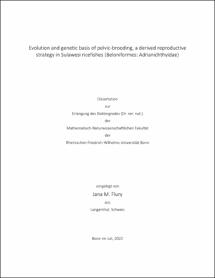Flury, Jana: Evolution and genetic basis of pelvic-brooding, a derived reproductive strategy in Sulawesi ricefishes (Beloniformes: Adrianichthyidae). - Bonn, 2022. - Dissertation, Rheinische Friedrich-Wilhelms-Universität Bonn.
Online-Ausgabe in bonndoc: https://nbn-resolving.org/urn:nbn:de:hbz:5-68221
Online-Ausgabe in bonndoc: https://nbn-resolving.org/urn:nbn:de:hbz:5-68221
@phdthesis{handle:20.500.11811/10394,
urn: https://nbn-resolving.org/urn:nbn:de:hbz:5-68221,
author = {{Jana Flury}},
title = {Evolution and genetic basis of pelvic-brooding, a derived reproductive strategy in Sulawesi ricefishes (Beloniformes: Adrianichthyidae)},
school = {Rheinische Friedrich-Wilhelms-Universität Bonn},
year = 2022,
month = nov,
note = {In Sulawesi ricefishes (Adrianichthyidae, Beloniformes) a derived reproductive strategy evolved. It is unique in the way that females of pelvic brooding species carry the eggs for up to 18 days until the fry hatches outside of their body, connected by attaching filaments which originate from the egg surface and are anchored within the females gonoduct. Several other morphological adaptations are related to pelvic brooding, like elongated pelvic fins and shortened ribs to form a ventral concavity. These traits are missing in transfer brooding, the more common and ancestral brooding strategy of the ricefishes. The most astonishing about the trait is that it appears in two distantly related lineages of Sulawesi ricefishes that are over 15 million years divergent and in between, several transfer brooding lineages evolved. Hence, various questions about its evolution might be asked. For example, did pelvic brooding evolve twice or is it an ancient trait that was lost several times? Is the genetic basis independent in the two lineages or were the same mechanisms involved? In this thesis I give a general introduction in chapter 1 about adaptation and how speciation can be fueled by hybridization. I introduce convergent evolution and connect it to introgression and I state why Sulawesi ricefishes are a suitable model to address fundamental questions of Evolutionary Biology. In chapter 2 I aim to investigate the genetic basis of pelvic brooding in the more recent lineage including Oryzias eversi. In chapter 3 I want to find out if gene flow into the stem lineage of Oryzias pelvic brooders could have fueled its evolution and in chapter 4, I compare the sex determination of the pelvic brooding O. eversi and its close relative, a transfer brooder O. nigrimas, to determine differences or similarities that might connect the sex determination with the sexually dimorphic traits related to the derived brooding strategy.},
url = {https://hdl.handle.net/20.500.11811/10394}
}
urn: https://nbn-resolving.org/urn:nbn:de:hbz:5-68221,
author = {{Jana Flury}},
title = {Evolution and genetic basis of pelvic-brooding, a derived reproductive strategy in Sulawesi ricefishes (Beloniformes: Adrianichthyidae)},
school = {Rheinische Friedrich-Wilhelms-Universität Bonn},
year = 2022,
month = nov,
note = {In Sulawesi ricefishes (Adrianichthyidae, Beloniformes) a derived reproductive strategy evolved. It is unique in the way that females of pelvic brooding species carry the eggs for up to 18 days until the fry hatches outside of their body, connected by attaching filaments which originate from the egg surface and are anchored within the females gonoduct. Several other morphological adaptations are related to pelvic brooding, like elongated pelvic fins and shortened ribs to form a ventral concavity. These traits are missing in transfer brooding, the more common and ancestral brooding strategy of the ricefishes. The most astonishing about the trait is that it appears in two distantly related lineages of Sulawesi ricefishes that are over 15 million years divergent and in between, several transfer brooding lineages evolved. Hence, various questions about its evolution might be asked. For example, did pelvic brooding evolve twice or is it an ancient trait that was lost several times? Is the genetic basis independent in the two lineages or were the same mechanisms involved? In this thesis I give a general introduction in chapter 1 about adaptation and how speciation can be fueled by hybridization. I introduce convergent evolution and connect it to introgression and I state why Sulawesi ricefishes are a suitable model to address fundamental questions of Evolutionary Biology. In chapter 2 I aim to investigate the genetic basis of pelvic brooding in the more recent lineage including Oryzias eversi. In chapter 3 I want to find out if gene flow into the stem lineage of Oryzias pelvic brooders could have fueled its evolution and in chapter 4, I compare the sex determination of the pelvic brooding O. eversi and its close relative, a transfer brooder O. nigrimas, to determine differences or similarities that might connect the sex determination with the sexually dimorphic traits related to the derived brooding strategy.},
url = {https://hdl.handle.net/20.500.11811/10394}
}






